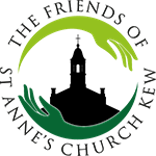Report on The Friends of St Anne’s Virtual Zoom Webinar Talk
TUESDAY 17TH NOVEMBER 2020
By Dr DAVID BELLINGHAM
We were delighted to welcome Dr David Bellingham – David is an art historian, author, and Programme Director for the master’s degree in Art Business at Sotheby’s Institute of Art, London. David has given three or so Lectures over the past 3 or 4 years – then of course live! Always attracting an excellent audience although St Anne’s parish hall can only hold 80 people maximum and we far exceeded that double in fact of 166 plus! Just shows some advantages of technology now in our ‘new normal’!
When David and I discussed the lecture back in October he was planning to introduce the exhibition at TATE BRITAIN on Turner scheduled to open on 28th October 2020 until 7th March 2021 which it did – but sadly had to close a week later due to the second lockdown.
However, that did not deter David having managed to view the exhibition in that short week it was open. This enabled him to deliver the most inspiring, captivating and so professionally researched lecture.
From very enthusiastic comments we received, the audience found it so well presented informing us of many things we had no idea about Turner leaving many of us wanting to see the movie ‘Mr Turner’ with Timothy Spall again. With David talking us through the layout of the Tate Britain Exhibition and how each room has been created, the theme of each room and so fascinating what other artists who either influenced Turner or had been influenced by Turner related about him. Fascinatingly many of his paintings had been compared to the Impressionists well before they came onto the market. (See note at end of report )
I am sure many members of our audience will flock to the Exhibition when it can finally open again being so well informed. David brought everything so alive for us and seeing the local places where Turner was born and lived namely Brentford, Isleworth, Twickenham, and Syon Park -so familiar to those of us living around there. David is such an excellent and accomplished speaker – his students are extremely lucky to be taught by him.
Further background to the Lecture
Joseph Mallard William Turner (1775–1851) was born during the first generation of the Industrial Revolution and lived through the cultural periods of Neo-Classicism, Romanticism, and the Greek Revival. He was very much a Londoner, being christened in St Paul’s, Covent Garden, dying in Cheyne Walk and buried in St Paul’s Cathedral. He was also a great traveller, wandering in search of romantic subjects throughout England, Wales and Scotland and the continent as far afield as Switzerland and the South of Italy. He knew Kew and its surrounding area well, living as a boy with his uncle in Brentford where he first started to make drawings, renting Ferry House on the river at Syon, and from 1811 designing a house in St Margaret’s Twickenham which is now open to visitors. The lecture will focus on those drawings and paintings which appear to reference the modern world in which Turner lived, culminating in the dynamically-titled Rain, Steam and Speed: The Great Western Railway (1844) where nature and culture at their most extreme are painted on collision course.
Several members of the Audience asked questions at the end of the lecture and one in particular about comparisons of some of Turner’s Paintings to the Impressionists prompted David to send us this summary below
Dear Lorraine and Nigel, I asked my Sotheby’s Institute colleague whether there were any primary sources which indicated the influence of Turner on Impressionists and he found this letter (see below) by Pissarro (who of course lived on Kew Green) to his son. So there is at least indirect evidence that when artists like Monet and Pissarro came to live in London they saw the NG Turners and admired them. Whether their actual works were influenced is another matter not yet resolved.
“You and Esther [cousin of Lucien, niece of Camille]have been to the National Gallery, you have seen the Turners, yet you don’t mention them. Can it be that the famous painting The Railway, The Burial of the Painter Wilkie, the astonishing Seascape, at the Kensington Museum, the View of Saint Mark in Venice, the little sketches retouched with watercolours of fish and fishing equipment, etc., did not impress you?”
Letter to Lucien, 20 February 1883. It’s actually the second letter after Lucien immigrates to London. And it comes over 10 years after Camille lived there, so I think it’s fair to say the works made a powerful impression on him.
Camille Pissarro, Letters to his Son Lucien, ed. John Rewald, trans. Lionel Abel (Boston: MFA, 2002), p. 22.
